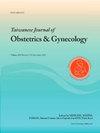Advanced high-grade serous carcinoma of the ovary after IVF treatment in a 38-year-old nulligravida: A case report of diagnostic challenges in the presence of OHSS
IF 2.2
4区 医学
Q2 OBSTETRICS & GYNECOLOGY
引用次数: 0
Abstract
Objective
When there is massive ascites in a patient who has recently undergone IVF treatment, differentiating OHSS from ovarian cancer can be challenging. A detailed evaluation combining clinical history, ultrasound characteristics, and laboratory findings is essential. In cases where these initial evaluations are inconclusive, advanced imaging and histopathological examination may be necessary to achieve an accurate diagnosis.
Case report
We report the case of a 38-year-old nulligravida woman with no family history of breast or ovarian cancer who presented with progressive exertional dyspnea and massive ascites six weeks after completing two cycles of in vitro fertilization (IVF) at a private fertility clinic. She was initially diagnosed and treated for ovarian hyperstimulation syndrome (OHSS)at the clinic, a known complication of controlled ovarian stimulation at the clinic. However, her symptoms persisted and progressed beyond the typical 10–14-day resolution period for mild-to-moderate OHSS.
Upon presentation to our internal thoracic outpatient department, physical examination and imaging revealed right-sided pleural effusion and estimated ascites more than 2000 mL. Abdominal computed tomography demonstrated a large, multilocular, hypodense cystic mass measuring 12 × 12 cm originating from the right adnexa, accompanied by bilateral pleural effusions and diffuse ascites, raising suspicion for an underlying ovarian malignancy. The patient underwent thoracentesis and paracentesis twice within a seven-day interval, each time draining over 200 mL of pleural fluid and 2500 mL of ascitic fluid. Despite repeatedly negative cytological findings, the clinical course and radiologic features warranted surgical exploration.
Laparotomy confirmed the diagnosis of high-grade serous carcinoma of the ovary with extensive peritoneal and pleural metastases. Given the patient's strong desire for fertility preservation, a suboptimal debulking procedure was performed, including right salpingo-oophorectomy, left salpingectomy, left ovarian cystectomy, tumor debulking, omentectomy, and enterolysis. Postoperatively, she commenced chemotherapy with carboplatin and paclitaxel. Although BRCA1/2 testing was negative, she was found to carry a homologous recombination repair (HRR) mutation, and maintenance therapy with a PARP inhibitor is being considered. Additionally, adoptive immunotherapy with cytokine-induced killer (CIK) cells is under evaluation as part of a multimodal treatment approach.
Conclusions
This case highlights the diagnostic challenges in differentiating OHSS from malignancy in IVF patients with persistent and atypical symptoms. Comprehensive diagnostic approaches, including imaging and surgical exploration, are crucial for accurate diagnosis and appropriate management.
38岁无孕妇女IVF治疗后晚期高级别卵巢浆液性癌:OHSS存在的诊断挑战的病例报告
目的:当近期接受体外受精治疗的患者出现大量腹水时,卵巢OHSS与卵巢癌的鉴别可能具有挑战性。结合临床病史、超声特征和实验室结果的详细评估是必要的。在这些初步评估不确定的情况下,可能需要先进的成像和组织病理学检查来实现准确的诊断。病例报告我们报告一例38岁无妊娠妇女,无乳腺癌或卵巢癌家族史,在私人生育诊所完成两个周期的体外受精(IVF)后6周出现进行性用力呼吸困难和大量腹水。她最初在诊所被诊断为卵巢过度刺激综合征(OHSS)并接受治疗,这是诊所控制卵巢刺激的一种已知并发症。然而,她的症状持续存在并进展超过了轻至中度OHSS典型的10 - 14天缓解期。在我们的内胸门诊就诊时,体格检查和影像学显示右侧胸腔积液,估计腹水超过2000毫升。腹部计算机断层扫描显示一个大的,多室的,低密度的囊性肿块,尺寸为12 × 12厘米,起源于右附件,伴有双侧胸腔积液和弥漫性腹水,引起对潜在卵巢恶性肿瘤的怀疑。患者在7天内进行了两次胸腔穿刺和胸腔外穿刺,每次引流超过200 mL的胸腔液和2500 mL的腹水。尽管反复阴性细胞学结果,临床过程和放射学特征值得手术检查。剖腹手术确诊为高度浆液性卵巢癌伴广泛腹膜及胸膜转移。考虑到患者保留生育能力的强烈愿望,我们实施了次优的减容手术,包括右侧输卵管卵巢切除术、左侧输卵管切除术、左侧卵巢囊肿切除术、肿瘤减容、网膜切除术和肠溶术。术后,患者开始卡铂和紫杉醇化疗。尽管BRCA1/2检测呈阴性,但她被发现携带同源重组修复(HRR)突变,正在考虑使用PARP抑制剂进行维持治疗。此外,使用细胞因子诱导杀伤(CIK)细胞的过继免疫疗法作为多模式治疗方法的一部分正在评估中。结论本病例强调了在具有持续和非典型症状的IVF患者中区分OHSS与恶性肿瘤的诊断挑战。全面的诊断方法,包括影像学和手术探查,对于准确诊断和适当治疗至关重要。
本文章由计算机程序翻译,如有差异,请以英文原文为准。
求助全文
约1分钟内获得全文
求助全文
来源期刊

Taiwanese Journal of Obstetrics & Gynecology
OBSTETRICS & GYNECOLOGY-
CiteScore
3.60
自引率
23.80%
发文量
207
审稿时长
4-8 weeks
期刊介绍:
Taiwanese Journal of Obstetrics and Gynecology is a peer-reviewed journal and open access publishing editorials, reviews, original articles, short communications, case reports, research letters, correspondence and letters to the editor in the field of obstetrics and gynecology.
The aims of the journal are to:
1.Publish cutting-edge, innovative and topical research that addresses screening, diagnosis, management and care in women''s health
2.Deliver evidence-based information
3.Promote the sharing of clinical experience
4.Address women-related health promotion
The journal provides comprehensive coverage of topics in obstetrics & gynecology and women''s health including maternal-fetal medicine, reproductive endocrinology/infertility, and gynecologic oncology. Taiwan Association of Obstetrics and Gynecology.
 求助内容:
求助内容: 应助结果提醒方式:
应助结果提醒方式:


